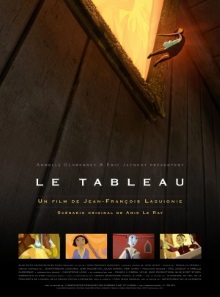
This is the last of a series of recommendations of interesting European animated films from a Chinese television program that my wife caught a long while ago. This one is obviously French and unlike so many animated films we’ve seen is apparently an original creation instead of being based on another property. However as is appropriate it derives its art style from a variety of famous artists including Henri Matisse and Pablo Picasso.
The characters of Le Tableau live inside a painting and they know it. Their world consists of a beautiful castle surrounded by a garden and beyond that is a forbidding castle. Unfortunately, the mysterious painter never finished painting all of the characters so the inhabitants are divided into three classes: the Toupins, or the fully painted, live in the castle and consider themselves superior to anyone else; the Pafinis, or the unfinished, who live in the garden and long to enter the castle; and the Reufs, or rough sketches without color, who are relegated to the forest and are picked on by everyone else. When a young Toupin named Ramo, falls in love with a Pafini named Claire, they incur the wrath of the leader of the Toupins. Ramo resolves to travel out of the painting and seek out the original painter so that he can complete the painting and eliminate the differences between them. He is joined in his quest by Claire’s friend Lola, another Pafini and a Reuf named Plume.
The film’s theme of discrimination is transparent and it offers no fresh insights. It’s even stereotypical enough to have one member from each class to compose their adventuring party and have the Toupins be led by a fat, pompous blowhard called Le Grand Chandelier. Still, there’s some novelty value in this presentation and I liked how Lola is a Pafini and not a Toupin only because her dress lacks a single daub of paint. I also like the idea of how each painting can be its own self-contained world. This is especially intriguing in the portrait of the nude woman in her boudoir with a single window to the outside. Step out of the window, and it’s the entire city of Venice. This fits in with the idea that authors of a work create an entire world even if the work itself shows only a tiny portion of it to the audience.
In the end I found this a pleasant enough film with some appealing aesthetic choices. But I found to be neither particularly remarkable nor memorable, which is why I don’t have much to say about it. The ending in particular is a bit of a cop-out. It’s cool and neat to question who painted the painter but ending the discrimination by having everyone be equally colorful is both too easy a solution and an affirmation that the original discrimination was justified in the first place. Then again, I suppose that why Lola didn’t feel the need to paint over the blank spot on her dress.